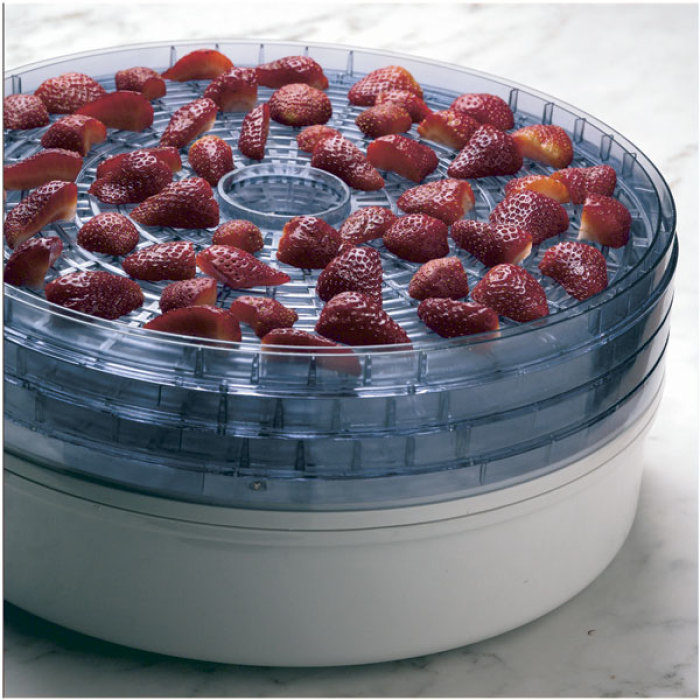
by Lynn Alley
April 1999
from issue #20
The taste of a ripe strawberry rivals that of any fruit, and its appearance in the youth of the growing season is a call for celebration. You may never tire of eating this berry out of hand, but months later when your plants stop yielding fruit, you may yearn for its sweet flavor. At the height of the strawberry season, freezing or making jam is always an option. Another way to preserve the great flavor of strawberries is by dehydration. Drying concentrates flavor, while the berries retain many vitamins and most minerals.
Of the three most popular methods of preserving foods—canning, freezing, and drying—drying is the oldest and most traditional. Schoolchildren learn how Native Americans dried berries and deer and buffalo meat in the sun. In Mexico, I have seen (but not tasted) sun-dried grasshoppers. In Sicily, housewives spread puréed tomatoes on a wooden table and after two days under the hot Sicilian sun, the purée becomes almost like putty, and is packed into jars for storage. Hot air, dry climate, and time—a winning combination.
The secret of dehydration lies in the fact that most bacteria, molds, and yeast need a moist environment in which to proliferate. By removing 80 to 90 percent of the strawberry’s moisture, you render it a less-than-attractive host for spoilage organisms. The only question that remains is how to proceed.
Sun, oven, or electric dehydrator?
You may choose to dehydrate your strawberries the old-fashioned way, using nothing more than sun and two or three warm days in succession. This method has been used for centuries and requires little besides strawberries sliced into thirds or quarters, some screens on which to lay the fruit, and protection from marauding insects and curious critters. The Food PANtrie solar dehydrator provides five trays with a zippered netting ($48.95 from The Sustainable Village) and a hanger for stringing in a tree.
Unfortunately, drying fruit in a humid climate or less-than-optimum weather conditions is risky business. Instead, consider using your oven. Oven drying is fairly easy and should be done on screens rather than cookie sheets to allow for better air circulation. Slice your strawberries just as you would for sun drying, in thirds or quarters, and lay the slices flat on screens, making sure the pieces don’t touch. Set the oven temperature as low as possible and open the oven door so air can circulate around the fruit. Optimum temperatures for drying fruit range between 90˚ and 140˚F. Anything above this and the fruit begins to cook. The berries will not all dry at the same time, so check them periodically and remove those that appear to be done—they should still be somewhat pliable. The dried berries will keep about a year in a freezer or six months stored in a cool, dry place.
If you intend to dry a lot of food, invest in an electric dehydrator. A good electric dehydrator should have both a temperature gauge and a fan for circulation. (You can check out a range of makes and models at Fern’s Nutrition.) It won’t take up much room., and it will fill your kitchen with the wonderful aroma of strawberries. Again, slice your berries in thirds or quarters, place them on the drying trays, set your temperature gauge and timer, and plug it in. You need only check from time to time to remove the berries that have finished drying.
Enjoy the fruits of your labor
One of the things I like most about dehydrating strawberries is that not only have I preserved the berries hemselves, but I have also preserved a precious moment in time. I will never eat a bowl of homemade granola studded with dried fraises des bois without recalling with great satisfaction the day I harvested and dried them. Using ripe, just-picked fruit means the final dried result will be a concentration of that same great flavor. In addition, many commercially dried fruits have been treated with sulfur prior to drying, whereas your berries will be just the way you grew them.
How to enjoy your dried strawberries? Eat them out-of-hand, added to homemade granola or trail mix, tossed into muffin, pancake, or even cookie batters, or made into strawberry butter. Months after harvest, you’ll recall that earlier day and its bounty of bright morsels of flavor.
Fine Gardening Recommended Products

A.M. Leonard Deluxe Soil Knife & Leather Sheath Combo
Fine Gardening receives a commission for items purchased through links on this site, including Amazon Associates and other affiliate advertising programs.

Hasegawa Tripod Ladder
Fine Gardening receives a commission for items purchased through links on this site, including Amazon Associates and other affiliate advertising programs.

Corona High Performance Orchard Loppers
Fine Gardening receives a commission for items purchased through links on this site, including Amazon Associates and other affiliate advertising programs.


















Comments
Log in or create an account to post a comment.
Sign up Log in